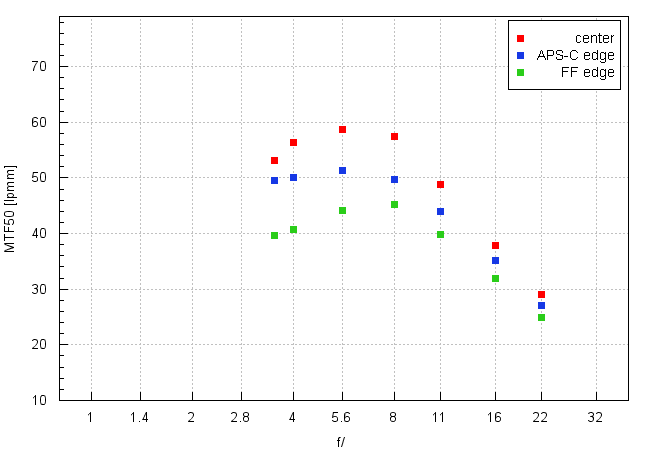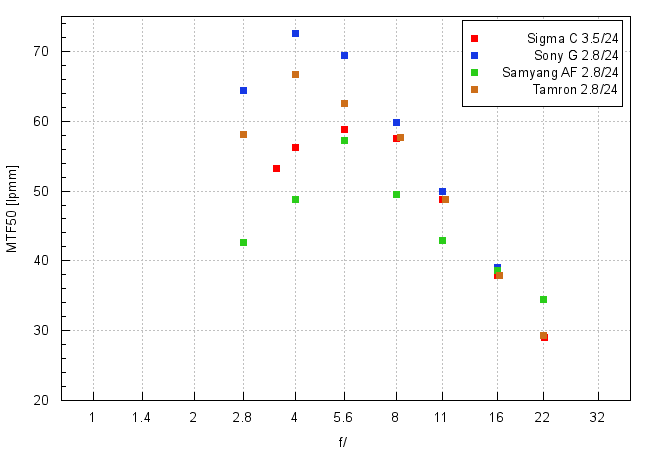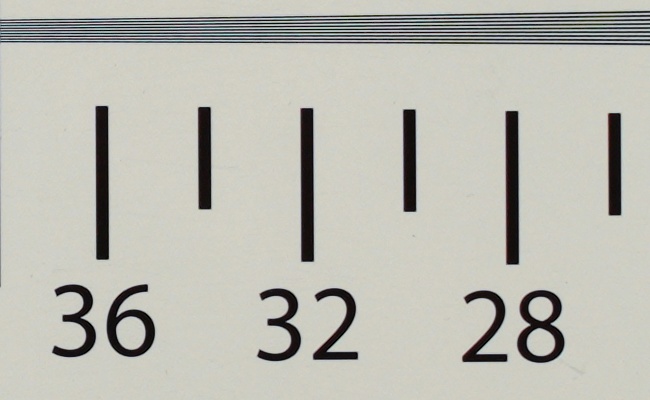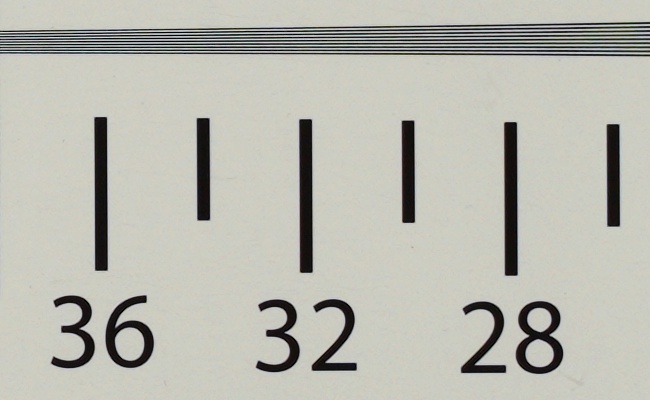Sigma C 24 mm f/3.5 DG DN
4. Image resolution
Let's check how the Sigma C 24 mm f/3.5 DG DN compares – its results in the frame centre, on the edge of the APS-C sensor and on the edge of full frame presents a graph below.

When you test slower primes, first you have to determine the proper reference points. It is obvious you can't expect any resolution records – these are usually achieved near f/2.8 and the tested Sigma simply doesn't have such an aperture. What maximum resolution levels will be appropriate in this case? The best fixed-focal lenses start working in difraction limit (so cut out the majority of optical aberrations) on stopping down by about 2-3 EV from their maximum relative apertures. Keeping that in mind the tested Sigma should work in diffraction limit near f/8.0 if its constructors did a good job.
Please Support UsIf you enjoy our reviews and articles, and you want us to continue our work please, support our website by donating through PayPal. The funds are going to be used for paying our editorial team, renting servers, and equipping our testing studio; only that way we will be able to continue providing you interesting content for free. |
- - - - - - - - - - - - - - - - - - - - - - - - - - - - - - - - - - - - - - - - - - - - - - - -
By f/8.0 the best Sony FE system primes can get as high as 63-64 lpmm and it is, in our opinion, the upper limit of the Sigma's possibilities. Taking it into account, the maximum performance the Sigma had in our test, amounting to 59 lpmm, should be considered a good result. If you add to that 53 lpmm this lens got at the maximum relative aperture, a result definitely above the decency level, there are really no reasons to complain.
It's also worth checking how the Sigma performs when compared to its direct rivals – the graph below shows results in the frame centre obtained by the tested Sigma and other lenses such as the Sony FE 24 mm f/2.8G, the Samyang AF 24 mm f/2.6 FE and the Tamron 24 mm f/2.8 Di III OSD M 1:2.

You have to mention the fact that the task of the Sigma was the most difficult here because all its rivals are faster. Despite that drawback the tested lens achieved better results than the Samyang but it was defeated in duels with the Tamron and the Sony.
You should also mention the performance on the edge of the frame. When it comes to the edges of the APS-C sensor we have no reservations whatsoever. Already up from the maximum relative aperture you deal with sensible values of 50 lpmm and on stopping down image quality even improves a bit.
The performance on the edge of full frame also doesn't give you any reasons to worry about. By f/3.5 and f/4.0 you land on the decency level and on stopping down the aperture MTFs become completely acceptable.
To sum up the Sigma C 3.5/24 doesn't have any weaknesses in the resolution category; its results are a tad weaker than those of some of its rivals but it stems mainly from inferior aperture fastness.
At the end of this chapter, traditionally, we present crops taken from photos of our resolution testing chart saved in JPEG format alongside RAW files which we used for the analysis above.
| A7R III, JPEG, 24 mm, f/3.5 |
 |
| A7R III, JPEG, 24 mm, f/5.6 |
 |






